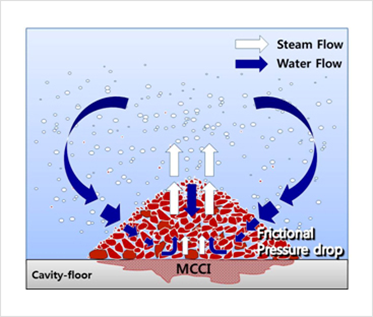원자력 안전 및 에너지 변환 분야 | Debris bed cooling
페이지 정보
2017.02.07 / 3,094관련링크
본문
In the late phase of severe accident in nuclear
power plants, it is important to assure the coolability of the relocated corium
in the reactor cavity. Under this circumstance, concrete ablation and
over-pressurization caused by molten core concrete interaction (MCCI) may
threaten the integrity of containment, the final barrier of the
defense-in-depth, to prevent the release of radioactive material to
environment. To ensure the long-term cooling of corium in the reactor cavity,
it is important to ensure the coolant ingression into the internally heat
generated corium debris bed which is affected by pressure drop in porous media
(Fig. 10.). For this reason, it is necessary to understand the pressure drop
mechanisms in the porous bed that can be characterized by physical parameters
that include porosity, particle morphology, particle size distributions etc.



